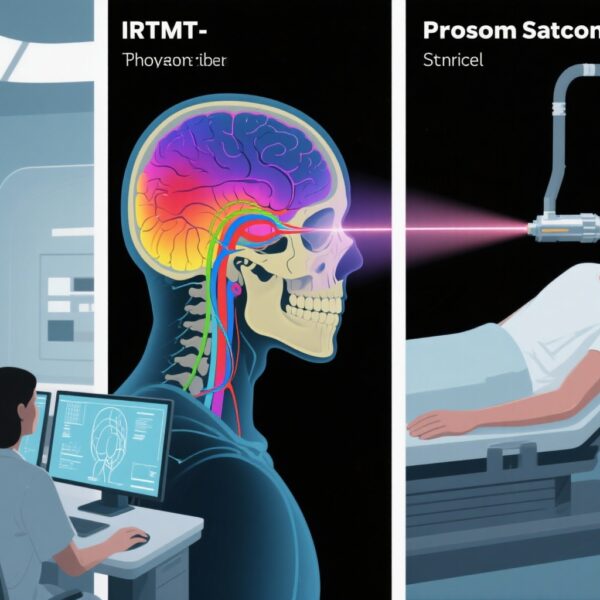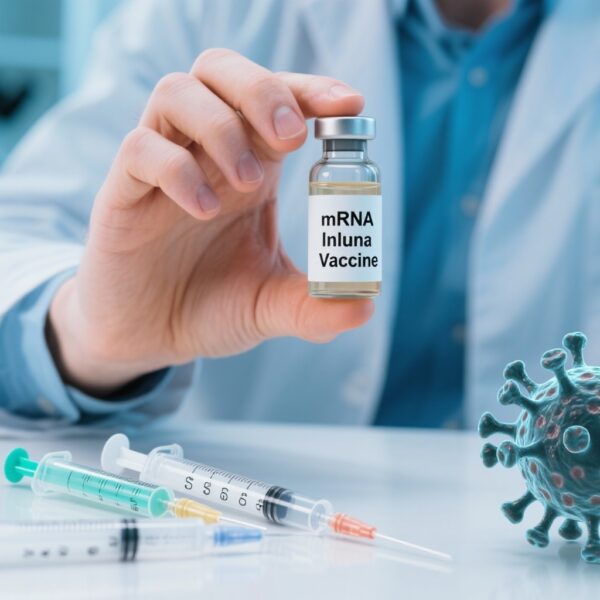Highlights
– In 158 patients with HPV-associated tonsillar squamous cell carcinoma (SCC), unilateral transoral robotic surgery (TORS) showed comparable oncologic outcomes to bilateral TORS with lower rates of some post‑operative complications.
– Oropharyngeal hemorrhage occurred in 7% after unilateral vs 15% after bilateral TORS (percent difference −7.8; 95% CI, −18.8% to 3.2%).
– Contralateral second primary tumors were rare (1.9% overall), suggesting routine prophylactic contralateral extracapsular tonsillectomy may be unnecessary in selected patients.
Background
The palatine tonsil is the most frequent subsite for human papillomavirus (HPV)-related oropharyngeal squamous cell carcinoma (OPSCC). HPV-positive OPSCC is a distinct clinical entity with favorable prognosis compared with tobacco-associated disease, and its rising incidence has made optimization of treatment to preserve function a priority. For appropriately selected patients, primary surgical management using transoral approaches, including transoral robotic surgery (TORS), is an established option. A persistent clinical question for lateralized tonsillar primaries is whether to perform an elective contralateral tonsillectomy at the time of resection to detect occult synchronous disease and reduce future second primaries. Prophylactic bilateral resections increase surgical extent and may carry additional morbidity; the balance of potential benefit versus harm has been uncertain.
Study design
Peterson and colleagues conducted a retrospective cohort study at a quaternary academic center evaluating consecutive patients with unilateral tonsillar SCC treated with primary TORS between June 2016 and July 2023. The cohort included 158 patients (106 unilateral TORS; 52 bilateral TORS). The cohort was predominantly male (including 18 women and 139 men) with mean (SD) age 60 (10) years. Treatment included ipsilateral radical tonsillectomy for all patients; for the bilateral group this was combined with contralateral extracapsular tonsillectomy. Adjuvant therapy (radiation ± chemotherapy) was given as indicated according to pathology findings (pathology-guided adjuvant treatment). The primary outcome was postoperative oropharyngeal hemorrhage. Secondary outcomes included 30‑day emergency department (ED) visit/hospitalization rates, time to nasogastric tube (NGT) removal, discharge with an NGT, g-tube dependence, length of stay (LOS), rates of contralateral second primary tumors, and 2-year and 5-year disease-free survival (DFS) and overall survival (OS). Analysis was performed between October 1, 2024 and January 1, 2025.
Key findings
The principal results can be summarized as follows:
Population
158 patients were assessed: 106 had unilateral TORS, and 52 had bilateral TORS. Demographics and baseline characteristics were reported by the authors; the aggregate cohort had a mean age of 60 years and the majority were men.
Primary outcome: oropharyngeal hemorrhage
Postoperative hemorrhage occurred in 7% of the unilateral group versus 15% of the bilateral group. The absolute percent difference was −7.8% (95% CI, −18.8% to 3.2%), favoring unilateral resection. Although confidence intervals cross zero, the magnitude and direction of effect are clinically meaningful and consistent with the hypothesis that additional contralateral mucosal resection increases bleeding risk.
Secondary perioperative outcomes
Thirty‑day ED visit or hospitalization rates were 9% after unilateral TORS vs 21% after bilateral TORS (percent difference −11.7%; 95% CI, −24.1 to 0.7), again favoring unilateral resection. Median length of stay was shorter after unilateral TORS (2 days) than after bilateral TORS (3 days). Time to NGT removal, rates of discharge with an NGT, and gastrostomy dependence did not differ significantly between groups. Swallowing outcomes were similar overall, suggesting that preserving the contralateral tonsillar tissue did not disadvantage short‑term functional recovery in this cohort.
Contralateral second primaries
Contralateral tonsil second primary tumors were rare: 3 patients (1.9%) in the whole series. Two metachronous primaries occurred in the unilateral group (1.8%), and one synchronous contralateral tumor was incidentally removed in the bilateral group (1.9%). These low rates suggest that routine prophylactic resection of a clinically and radiographically uninvolved contralateral tonsil detects very few additional cancers.
Oncologic outcomes
Two‑ and five‑year DFS and OS were not significantly different between unilateral and bilateral TORS groups. The authors conclude that oncologic control was not compromised by omitting elective contralateral extracapsular tonsillectomy in appropriately selected patients when pathology‑guided adjuvant therapy was used.
Interpretation and clinical implications
This study provides clinically relevant evidence to support a selective approach to contralateral tonsil management during TORS for HPV-positive tonsillar SCC. Key implications include:
- Low incidence of contralateral synchronous or metachronous tumors (≈1.9%) argues against routine prophylactic contralateral tonsillectomy in patients without clinical or radiographic evidence of contralateral disease.
- Trends toward lower posttonsillectomy hemorrhage, fewer postoperative ED visits, and shorter hospital stay with unilateral TORS suggest potential patient safety and resource-use benefits when contralateral tonsil is spared.
- Oncologic outcomes appear preserved when contralateral resection is omitted and adjuvant therapy is applied per final pathology, supporting a pathology-driven, risk‑stratified treatment paradigm.
Expert commentary and limitations
Strengths of the study include a contemporary cohort treated at a high-volume academic center, a clearly defined exposure (unilateral vs bilateral extracapsular tonsillectomy), and clinically meaningful outcome measures (hemorrhage, ED visits, LOS, and survival). The study addresses a practical and common surgical decision and provides outcome data that can inform shared decision-making.
Limitations that temper interpretation:
- Retrospective, single‑center design introduces risk of selection bias and confounding by indication: surgeons may have chosen bilateral resection for tumors felt to be closer to midline or for other perceived higher‑risk features, which can bias outcome comparisons.
- Although trends favored unilateral TORS for several complications, confidence intervals for some comparisons crossed zero; the study may be underpowered to detect small but meaningful differences.
- Details about follow‑up duration are necessary to fully interpret metachronous occurrence rates; longer follow-up in larger cohorts could identify additional contralateral events.
- Findings apply to HPV-positive tonsillar primaries and may not be generalizable to other OPSCC subsites (e.g., base of tongue) or to non-HPV-related disease.
Current guidelines and surgical practice increasingly favor deintensification and organ-preserving approaches for HPV-associated OPSCC when oncologically appropriate. This report aligns with that trend by showing limited oncologic downside and potential perioperative benefits of avoiding routine contralateral tonsillectomy for well‑selected, lateralized tonsil tumors.
Practical recommendations
Based on the study and current practice principles, clinicians may consider the following approach:
- Reserve contralateral tonsillectomy for patients with clinical, endoscopic, or radiographic evidence of contralateral involvement or for tumors that cross midline or have suspicious mucosal extension.
- Routinely obtain thorough preoperative assessment of the contralateral tonsil with physical examination, office endoscopy, and cross-sectional imaging (or PET/CT where indicated) to identify occult disease.
- Discuss with patients the low but finite risk of future contralateral primary tumor if the contralateral tonsil is preserved, balanced against higher immediate perioperative morbidity with bilateral resection.
- Use pathology‑guided adjuvant therapy and vigilant surveillance to manage occult disease that becomes evident postoperatively.
Future research
Prospective, multicenter studies or registries with standardized selection criteria, longer follow‑up, and formal quality‑of‑life assessments would strengthen evidence on this topic. Randomized controlled trials would be difficult logistically and ethically given surgeon and patient preferences, but carefully designed prospective observational studies could yield high‑quality comparative data. Cost‑effectiveness analyses that incorporate perioperative complications, downstream surveillance, and potential salvage therapies would also be informative.
Conclusion
In this retrospective cohort of 158 patients with HPV-associated tonsillar SCC, omission of prophylactic contralateral extracapsular tonsillectomy during TORS was not associated with inferior oncologic outcomes and was associated with trends toward fewer hemorrhagic complications, fewer ED visits for postoperative issues, and shorter hospital stay. Contralateral second primaries were uncommon (≈1.9%). These findings support a selective approach in which contralateral tonsillectomy is reserved for cases with clinical or radiographic concern rather than performed routinely. Shared decision‑making, careful preoperative assessment, pathology‑guided adjuvant treatment, and close surveillance remain essential.
Funding and clinicaltrials.gov
Funding and detailed disclosures were reported in the original article: Peterson AM et al., JAMA Otolaryngol Head Neck Surg. 2025;151(12):1–9. This analysis represents a retrospective cohort study and not a registered interventional trial.
References
1. Peterson AM, Bockover SR, Kallogjeri D, Chang K, Tharakan T, Harbison RA, Zolkind P, Rich JT, Pipkorn P, Puram SV, Jackson RS. Unilateral vs Bilateral Transoral Robotic Surgery for HPV-Positive Tonsillar Squamous Cell Carcinoma. JAMA Otolaryngol Head Neck Surg. 2025 Jul 10;151(12):1–9. doi: 10.1001/jamaoto.2025.1833. Epub ahead of print. Erratum in: JAMA Otolaryngol Head Neck Surg. 2025 Oct;151(10):1012. doi: 10.1001/jamaoto.2025.2804. PMID: 40638110; PMCID: PMC12246949.
2. Ang KK, Harris J, Wheeler R, Weber R, Rosenthal DI, Nguyen-Tan PF, et al. Human papillomavirus and survival of patients with oropharyngeal cancer. N Engl J Med. 2010 Jul 1;363(1):24–35. doi:10.1056/NEJMoa0912217.
AI image prompt for article thumbnail
“A head-and-neck surgeon consulting with a middle-aged male patient in a modern clinic, pointing to a 3D rendering of the oropharynx that highlights the palatine tonsils; subtle robotic arms and surgical instruments visible in background; clinical blue-green palette, realistic lighting, focused, professional mood, high detail.”



